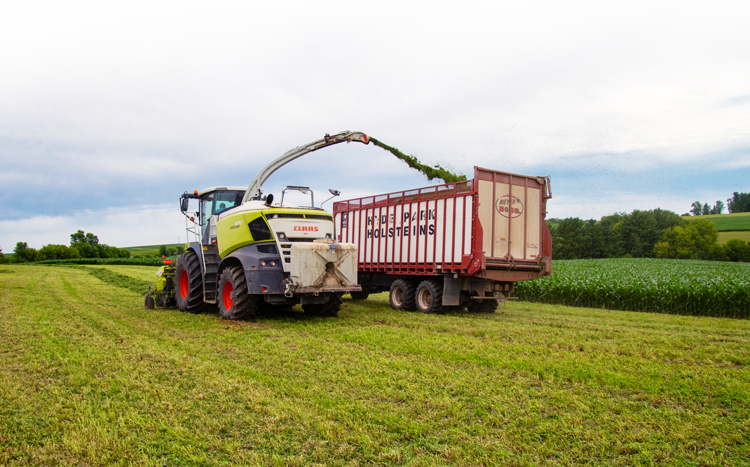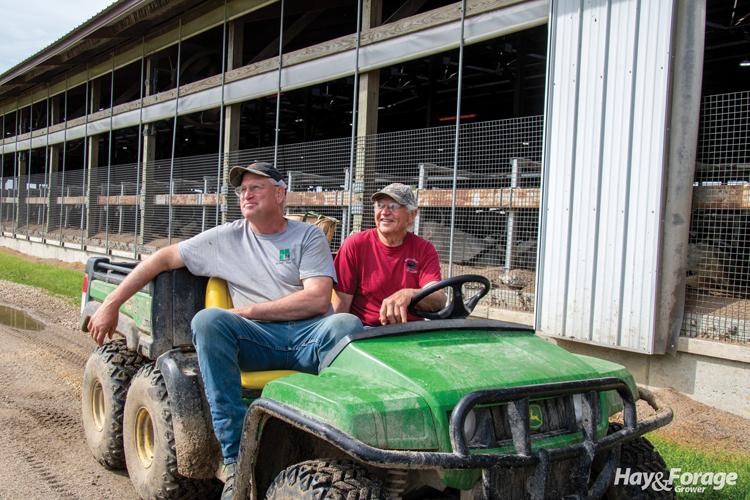
Wabasha, Minn., may ring a bell as the setting of the 1993 comedy film “Grumpy Old Men.” The county seat for Wabasha County is wedged between the Mississippi and Zumbro Rivers in the southeast corner of the Gopher State, which contains countless acres of contoured crop fields across the sloping landscape. These include the hayfields, cornfields, and those seeded to small cereal grains that belong to Hyde Park Holsteins, a dairy located 30 miles west of the classic movie set where the farmers — and their cattle — can hardly be described as grumpy.
Kevin Siewert owns and operates Hyde Park Holsteins along with his father, Kerwin, and oldest son, Justin. Kerwin grew up on the dairy near the small town of Zumbro Falls before earning a doctorate in ruminant nutrition and teaching at the University of Illinois for one year. Then, he returned to the dairy in 1970 and milked 60 cows in a tie stall barn before expanding the herd to 200 head when Siewert came home to farm full time in 1995.
Subsequent expansions in the years to follow led to the approximately 700 milking cows that reside on the dairy today. As cow numbers have climbed, so have the number of alfalfa acres in order to maintain forage levels in the dairy’s rations. Siewert has always prioritized high-haylage diets because it’s a practice that not only bolsters greater milk production, better components, and improved animal health, but also promotes good land stewardship on the rolling hills of Minnesota’s Driftless Region.
Alfalfa gets an A+
Haylage comprises roughly 42% of total forage in milking cow rations at Hyde Park Holsteins. Ben Flueger, a dairy production consultant with Ag Partners and the dairy’s nutritionist, has found the same metric on similarly sized farms typically ranges from 25% to 33%. While it’s not uncommon for smaller operations to have higher haylage inclusion rates, Flueger noted that’s not always the case for larger farms he works with.
“The larger farms get, it seems like diets go more and more toward higher corn silage levels,” Flueger said. “As Hyde Park Holstiens has grown, they continue to increase their hay acres to keep feeding similar rates of haylage.”
One reason alfalfa is replaced by corn when dairies scale upward is because the latter offers greater yield per acre. Being an annual crop, corn also only warrants one harvest per year, as opposed to the more intensive management of the perennial legume. With that said, there are other advantages of a high-haylage diet when alfalfa is out of the field and in the feedbunk.
“It seems like higher corn silage diets lend themselves to potentially more digestive health issues,” Flueger said. “That is one thing Hyde Park is very resilient on. Their forage management is definitely a big part of it, but I would give credit to more alfalfa — and more effective fiber from alfalfa — in the diet.”

More effective fiber from alfalfa may also contribute to the dairy’s high milking performance, which has earned them a long-standing spot at the top of the Minnesota Dairy Herd Improvement Association’s Herd Honor Roll. The award is based on the dollar value of rolling herd averages for pounds of fat, protein, and total milk per cow. For Hyde Park Holsteins, those numbers were 1,590 pounds of fat, 1,098 pounds of protein, and 33,951 pounds of milk per cow in 2023.
Forage philosophy
Siewert currently grows about 600 acres of alfalfa and 400 acres of corn for silage. He exclusively seeds alfalfa varieties with the HarvXtra trait and cuts forage four times per year.
With HarvXtra alfalfa, Siewert could hypothetically lengthen his cutting schedule and capture higher yields without a significant hit to forage quality, but he sticks to a strict 22-day harvest interval for the first three cuttings. He then extends this period to 40 to 44 days before taking a fourth and final cutting in mid-August to let plants restore their root carbohydrates. This lower quality cutting is fed to heifers.
“Before HarvXtra came out, we were always harvesting every 22 to 24 days, but then HarvXtra just made it better,” Siewert said. “We let the roots replenish before the fourth cutting. If you cut the last interval short, then it’s hard for plants to survive the winter.”
After the seeding year, alfalfa stands typically last three years before being rotated to corn for silage. Siewert has also added barley to his crop rotation, planting about 200 acres of the small cereal grain in the spring and chopping it for heifer feed. Then, he spreads manure on these fields before direct seeding alfalfa again.
“We try to let the barley get kind of ripe because we want more fiber out of it; we want it to be more of a filler,” Siewert stated. “Our goal is to feed heifers a lot of forage and get them to grow. I want them to be big enough so that when they come into milk, they don’t have to keep growing.”
Equipment and inventory
Siewert co-owns a Claas 970 chopper with another farmer located 20 miles southwest of Zumbro Falls near the town of Plainview. The two dairymen conspired the deal more than a decade ago when their mutual custom forage harvester retired. They each pay for the hours they run the chopper every season, and they own the rest of their harvest equipment individually.
Siewert runs two Krone triple mowers plus one Pöttinger model, an Oxbo merger, and has several box trucks and hay wagons to haul forage from the field to the silage pad. All of his haylage is inoculated to conserve forage quality, packed into bunker silos, and protected by SiloStop oxygen barrier film before the pile is sealed with plastic and covered with tires.

“They do all of the little things right when it comes to forages,” Flueger asserted. “They put a priority on getting alfalfa harvested on time, they do a great job at covering the pile in double layers of plastic, and they have excellent tire coverage.”
Doing the little things right is especially critical for long-term storage. Siewert always maintains a year’s worth of haylage to ensure forage supplies are sufficient in case of spoilage, drought, or winterkill. It was the latter factor that inspired more inventory when a large percentage of his alfalfa acres winterkilled in 2013. Since then, forage yields have fluctuated with other inclement weather events and variable moisture levels at harvest, which reinforces the importance of having a backup plan.
“One year, it was 90ºF with no humidity and the wind blew so hard we couldn’t chop fast enough. We had a dry pile that we fed out, but it cost us a lot because it wasn’t any good,” Siewert recalled. “We weren’t going to let that happen the next year, so we chopped a little too wet, and that pile went butyric. That fed the neighbor’s beef cows for a year,” he chuckled.
“In theory, if I have a 100% wipeout, I still have enough haylage to make it to the next year,” Siewert continued. Another benefit to having a bumper crop of haylage is that when the stars align to expand the herd again, Siewert won’t have to scramble to buy feed for more cows.
Oh, brothers
All four of Siewert’s sons want to farm full time. Justin officially became a business partner in 2022 in addition to working for a commodity trading company in the Twin Cities. Jake, who currently installs software for ParlorBoss, also anticipates ending up on the home farm long term. The same can be said for Blake and Lee, who are currently in high school and college, respectively.
Family ties also extend beyond the Siewert bloodline to encompass a 12-person full-time team and a handful of part-time employees. Some specialize in agronomy and lend their skills to forage harvest and storage, whereas others can primarily be found in the barns and the parlor. Siewert noted the care and compassion his employees offer to cows, from focusing on overall cow health and comfort to knowing individual animals by name, ear tag number, and markings.
“I think the thing we are most proud of is that we have good people to take care of the cows every day,” the affable dairyman affirmed. “We have super people who make it all work; we couldn’t ask for better help.”
It’s this acknowledgement and appreciation that make long hours in the field and on the farm worthwhile. Forage quality and milk production aside, Siewert said he is happiest with his people and their commitment to show up for his cows — and for each other — day in and day out. With this emphasis on teamwork and expression of gratitude at Hyde Park Holsteins, there is not a grumpy soul in sight.

